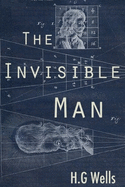

(A quick note on editions: The Invisible Man was first published over the course of a few weeks in Pearson's Weekly magazine. Let's remember, though, that Wells' story goes much, much deeper. The Invisible Man has been the basis for a lot of exciting movies and TV shows, and that's how we generally remember the story today: a fun story about a crazy invisible guy. It doesn't surprise us: who doesn't feel invisible when they're young and just starting to make a name in the world? There's a scene in Wells' autobiographical novel Tono-Bungay (1908) where the main character moves to a big city and feels invisible.


And, of course, they were both invisible. They were both poor, they both worked as teachers, and they both had innovative ideas. The Invisible Man is actually a lot like his creator, H.G. It's the story of how one person can fit into society or rather, fail to fit into society.īut wait: this isn't just a tale of any old guy. What makes The Invisible Man special is that it's not about a monster – it's about a man. Tolkien's ring from The Fellowship of the Ring? It should.) There are also a bunch of really fun horror stories from the 1800s about invisible monsters, like Fitz-James O'Brien's "What Was it? A Mystery" (1859), Guy de Maupassant's "The Horla" (1887), and Ambrose Bierce's "The Damned Thing" (1893). Long story short, the ring gets used for evil. In the Republic, Plato wrote a story about the Ring of Gyges that allowed the wearer to become invisible. In fact, we could trace the invisible guy back to Greek myths, too. The mad scientist is an idea that we can probably trace back to Daedalus from Greek myths (or at least to Frankenstein). Of course Wells didn't invent the mad scientist or the concept of invisibility. Only this time, instead of traveling through time or making animals into people, the main character of The Invisible Man – spoiler alert! – creates an invisibility formula. The Invisible Manwas published in 1897 and like many of Wells' other stories, it features an eccentric and possibly mad scientist-inventor. He had just become a professional writer and had already invented (or gave modern form to) a bunch of classic science fictional concepts, like time travel (in The Time Machine ) and alien invasion (in The War of the Worlds ). Wells was on a real hot streak in the 1890s.


 0 kommentar(er)
0 kommentar(er)
